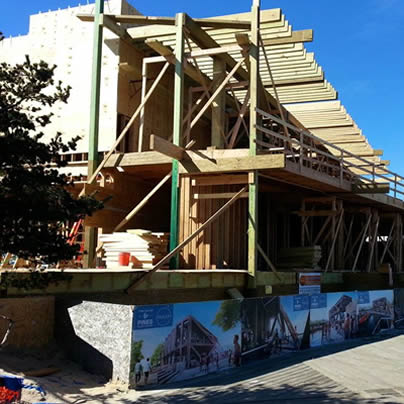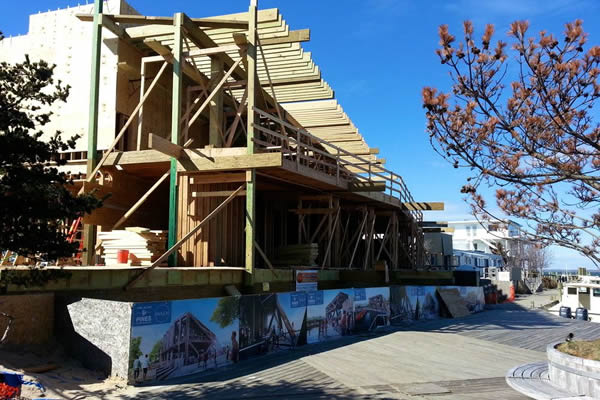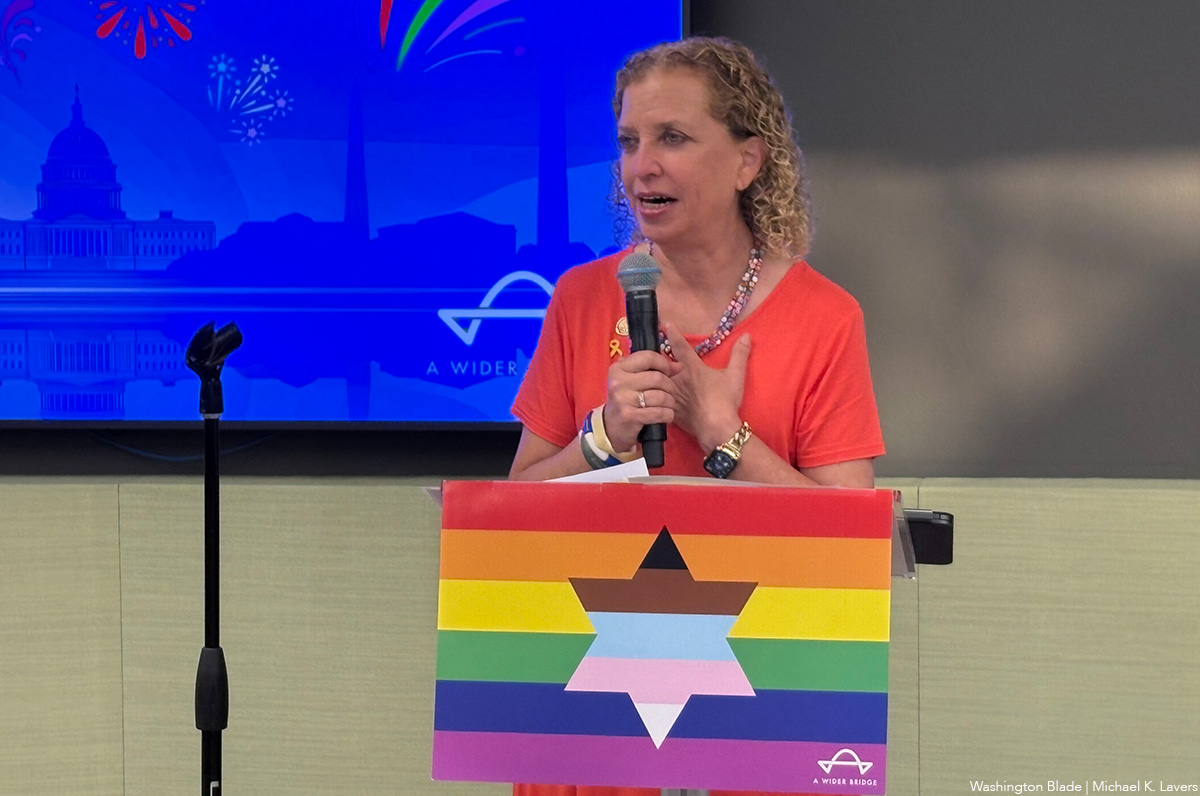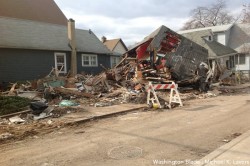National
Fire Island continues post-Sandy recovery
Gay business owners prepare for new season after storm


Crews continue to reconstruct the Pavilion nightclub in Fire Island Pines, N.Y., after a Nov. 2011 fire destroyed it. (Photo courtesy of FIP Ventures)
More than four months after Superstorm Sandy devastated the New York and New Jersey coastline, residents and business owners on Fire Island continue to prepare for the upcoming season.
Diane Romano, president of the Cherry Grove Community Association, told the Washington Blade on Tuesday the beachfront dunes that had been damaged during Sandy have begun to rebuild because of dune fencing the hamlet installed immediately after the storm.
The storm surge that reached nearly 14 feet in parts of New York City and Long Island flooded dozens of bay front homes, damaged a number of boardwalks and destroyed beach accesses. In spite of this damage, Romano stressed Cherry Grove weathered Sandy relatively well compared to other Fire Island communities.
“The people of Cherry Grove seem to be thankful and looking forward to a great season,” she said.
Jay Pagano, president of the Fire Island Pines Property Owners Association, said “necessary repairs” to the harbor are underway. He said the resort’s marina will be “up and running” by April 15, and debris removal will be completed by the end of this month.
Construction on the Pavilion, a nightclub that burned to the ground during a November 2011 fire that destroyed several other businesses in the Fire Island Pines commercial district, continues. It is slated to open later this spring in time to commemorate the gay resort’s 60th anniversary.
“The new Pines Pavilion complies to a heightened [Federal Emergency Management Agency] sea level, and none of the crucial elements of the building were touched by water,” Matthias Hollwich of Hollwich Kushner Architects, which designed the building, said. “Thankfully the foundations are deep and strong enough to easily withstand Sandy. The only challenge that we experienced was a delay in construction.”
The storm washed several oceanfront homes in Davis Park, a hamlet that is roughly two miles east of Fire Island Pines, out to sea. Dozens of others along the 34-mile long barrier island east of New York City also suffered damage.
The surge also caused numerous overwashes and at least three breaches — including one on the eastern end of Fire Island through which water continues to flow between the ocean and the Great South Bay.
The debris removal process had been delayed because of controversy over the bidding process through which the U.S. Army Corps of Engineers awarded the contract. The National Park Service’s announcement last month that it would begin to enforce a state law on some Fire Island beaches that bans public nudity, in part because Sandy destroyed the dunes that had obstructed nude sunbathers, sparked outrage among some. It does not, however, apply to Fire Island Pines or Cherry Grove.
‘We’re still kind of homeless’
Gay Staten Island residents with whom the Blade spoke roughly a month after Sandy made landfall continue to struggle to recover from the storm.
Up to six feet of water inundated Wayne Steinman and Sal Iacullo’s oceanfront townhouse on Father Capodanno Boulevard in the borough’s Midland Beach neighborhood during Sandy. The couple continues to live with Ianullo’s parents in Brooklyn as they try to repair their home.
Contractors have replaced the condominium’s back and side walls. A new furnace and hot water heater have been installed, but Steinman said he cannot begin the bulk of the needed structural repairs until he receives a payout from his insurance company.
“It’s really very, very frustrating,” Steinman said. “We’re still kind of homeless.”
Allison Galdorisi and Claire Watson fled their home in the Cedar Grove neighborhood of Staten Island during the height of the storm as several feet of water inundated the area.
Galdorisi told the Blade on Wednesday she and her wife “cleaned and dried the house out really quickly,” but the couple continues to rent an apartment in Midland Beach. The women are considering lifting their home to meet new FEMA flood standards, or even accepting a buyout that would take more than a year to complete.
“We’re just stuck,” Galdorisi said. “We’re pretty much out of shock and going into this new shock of not knowing what’s the best thing to do.”
Staten Island resident Michele Karlsberg, who is lesbian comedian Kate Clinton’s publicist, coordinated volunteer efforts in the borough in the weeks after Sandy.
She said her mother will move back into her apartment in the borough’s Ocean Breeze neighborhood that had eight feet of water inside it after the storm on March 15. Karlsberg added her sister has spent $30,000 so far to repair her home.
“The zone looks the same as if it was day one,” she said.
Sandy also inundated the Ali Forney Center’s drop-in center for homeless LGBT youth near the Hudson River in Manhattan’s West Chelsea neighborhood.
Gay MSNBC anchor Thomas Roberts and his husband, Patrick Abner, were among those who helped the organization raise funds to recoup some of their losses and to help pay for some of the renovations to a second drop-in center that opened in Harlem less than two months after the storm. The new facility does not yet have showers or medical facilities for the 60 young people who access it each day, but Ali Forney Center Executive Director Carl Siciliano stressed he feels his organization has recovered well from the storm.
“Because of that really strong support, we were able to pretty quickly get back on our feet,” he said.

A Wider Bridge on Friday announced it will shut down at the end of the month.
The group that “mobilizes the LGBTQ community to fight antisemitism and support Israel and its LGBTQ community” in a letter to supporters said financial challenges prompted the decision.
“After 15 years of building bridges between LGBTQ communities in North America and Israel, A Wider Bridge has made the difficult decision to wind down operations as of Dec. 31, 2025,” it reads.
“This decision comes after challenging financial realities despite our best efforts to secure sustainable funding. We deeply appreciate our supporters and partners who made this work possible.”
Arthur Slepian founded A Wider Bridge in 2010.
The organization in 2016 organized a reception at the National LGBTQ Task Force’s Creating Change Conference in Chicago that was to have featured to Israeli activists. More than 200 people who protested against A Wider Bridge forced the event’s cancellation.
A Wider Bridge in 2024 urged the Capital Pride Alliance and other Pride organizers to ensure Jewish people can safely participate in their events in response to an increase in antisemitic attacks after Hamas militants attacked Israel on Oct. 7, 2023.
The Jewish Telegraphic Agency reported authorities in Vermont late last year charged Ethan Felson, who was A Wider Bridge’s then-executive director, with lewd and lascivious conduct after alleged sexual misconduct against a museum employee. Rabbi Denise Eger succeeded Felson as A Wider Bridge’s interim executive director.
A Wider Bridge in June honored U.S. Rep. Debbie Wasserman Schultz (D-Fla.) at its Pride event that took place at the Capital Jewish Museum in D.C. The event took place 15 days after a gunman killed two Israeli Embassy employees — Yaron Lischinsky and Sarah Milgrim — as they were leaving an event at the museum.
“Though we are winding down, this is not a time to back down. We recognize the deep importance of our mission and work amid attacks on Jewish people and LGBTQ people – and LGBTQ Jews at the intersection,” said A Wider Bridge in its letter. “Our board members remain committed to showing up in their individual capacities to represent queer Jews across diverse spaces — and we know our partners and supporters will continue to do the same.”
Editor’s note: Washington Blade International News Editor Michael K. Lavers traveled to Israel and Palestine with A Wider Bridge in 2016.
The White House
‘Trump Rx’ plan includes sharp cuts to HIV drug prices
President made announcement on Friday

President Donald Trump met with leaders from some of the world’s largest pharmaceutical companies at the White House on Friday to announce his new “Trump Rx” plan and outline efforts to reduce medication costs for Americans.
During the roughly 47-minute meeting in the Roosevelt Room, Trump detailed his administration’s efforts to cut prescription drug prices and make medications more affordable for U.S. patients.
“Starting next year, American drug prices will come down fast, furious, and will soon be among the lowest in the developed world,” Trump said during the meeting. “For decades, Americans have been forced to pay the highest prices in the world for prescription drugs by far … We will get the lowest price of anyone in the world.”
Trump signed an executive order in May directing his administration “to do everything in its power to slash prescription drug prices for Americans while getting other countries to pay more.”
“This represents the greatest victory for patient affordability in the history of American health care, by far, and every single American will benefit,” he added.
Several pharmaceutical executives stood behind the president during the announcement, including Sanofi CEO Paul Hudson, Novartis CEO Vas Narasimhan, Genentech CEO Ashley Magargee, Boehringer Ingelheim (USA) CEO Jean-Michel Boers, Gilead Sciences CEO Dan O’Day, Bristol Myers Squibb General Counsel Cari Gallman, GSK CEO Emma Walmsley, Merck CEO Robert Davis, and Amgen Executive Vice President Peter Griffith.
Also in attendance were Health and Human Services Secretary Robert F. Kennedy Jr., Commerce Secretary Howard Lutnick, Centers for Medicare and Medicaid Services Administrator Mehmet Oz, and Food and Drug Administration Commissioner Marty Makary.
Under the Trump Rx plan, the administration outlined a series of proposed drug price changes across multiple companies and therapeutic areas. Among them were reductions for Amgen’s cholesterol-lowering drug repatha from $573 to $239; Bristol Myers Squibb’s HIV medication reyataz from $1,449 to $217; Boehringer Ingelheim’s type 2 diabetes medication jentadueto from $525 to $55; Genentech’s flu medication xofluza from $168 to $50; and Gilead Sciences’ hepatitis C medication epclusa from $24,920 to $2,425.
Additional reductions included several GSK inhalers — such as the asthma inhaler advair diskus 500/50, from $265 to $89 — Merck’s diabetes medication januvia from $330 to $100, Novartis’ multiple sclerosis medication mayzent from $9,987 to $1,137, and Sanofi’s blood thinner plavix from $756 to $16. Sanofi insulin products would also be capped at $35 per month’s supply.
These prices, however, would only be available to patients who purchase medications directly through TrumpRx. According to the program’s website, TrumpRx “connects patients directly with the best prices, increasing transparency, and cutting out costly third-party markups.”
Kennedy spoke after Trump, thanking the president for efforts to lower pharmaceutical costs in the U.S., where evidence has shown that drug prices — including both brand-name and generic medications — are nearly 2.78 times higher than prices in comparable countries. According to the Pharmaceutical Research and Manufacturers of America, roughly half of every dollar spent on brand-name drugs goes to entities that play no role in their research, development, or manufacturing.
“This is affordability in action,” Kennedy said. “We are reversing that trend and making sure that Americans can afford to get the life-saving solutions.”
Gilead CEO Dan O’Day also spoke about how the restructuring of drug costs under TrumpRx, combined with emerging technologies, could help reduce HIV transmission — a virus that, if untreated, can progress to AIDS. The LGBTQ community remains disproportionately affected by HIV.
“Thank you, Mr. President — you and the administration,” O’Day said. “I think this objective of achieving the commitment to affordability and future innovation is extraordinary … We just recently launched a new medicine that’s only given twice a year to prevent HIV, and we’re working with Secretary Kennedy and his entire team, as well as the State Department, as a part of your strategy to support ending the epidemic during your term.
“I’ve never been more optimistic about the innovation that exists across these companies and the impact this could have on America’s health and economy,” he added.
Trump interjected, asking, “And that’s working well with HIV?”
“Yes,” O’Day replied.
“It’s a big event,” Trump said.
“It literally prevents HIV almost 100 percent given twice a year,” O’Day responded.
A similar anti-HIV medication is currently prescribed more than injectable form mentioned by O’Day. PrEP, is a medication regimen proven to significantly reduce HIV infection rates for people at high risk. Without insurance, brand-name Truvada can cost roughly $2,000 per month, while a generic version costs about $60 per month.
Even when medication prices are reduced, PrEP access carries additional costs, including clinic and laboratory fees, office visits, required HIV and sexually transmitted infection testing, adherence services and counseling, and outreach to potentially eligible patients and providers.
According to a 2022 study, the annual total cost per person for PrEP — including medication and required clinical and laboratory monitoring — is approximately $12,000 to $13,000 per year.
The TrumpRx federal platform website is now live at TrumpRx.gov, but the program is not slated to begin offering reduced drug prices until January.
The White House
EXCLUSIVE: Democracy Forward files FOIA lawsuit after HHS deadnames Rachel Levine
Trans former assistant health secretary’s name changed on official portrait

Democracy Forward, a national legal organization that works to advance democracy and social progress through litigation, policy and public education, and regulatory engagement, filed a lawsuit Friday in federal court seeking to compel the U.S. Department of Health and Human Services to release information related to the alteration of former Assistant Secretary for Health Adm. Rachel Levine’s official portrait caption.
The lawsuit comes in response to the slow pace of HHS’s handling of multiple Freedom of Information Act requests — requests that federal law requires agencies to respond to within 20 working days. While responses can take longer due to backlogs, high request volumes, or the need for extensive searches or consultations, Democracy Forward says HHS has failed to provide any substantive response.
Democracy Forward’s four unanswered FOIA requests, and the subsequent lawsuit against HHS, come days after someone in the Trump-Vance administration changed Levine’s official portrait in the Hubert H. Humphrey Building to display her deadname — the name she used before transitioning and has not used since 2011.
According to Democracy Forward, HHS “refused to release any records related to its morally wrong and offensive effort to alter former Assistant Secretary for Health Admiral Rachel Levine’s official portrait caption.” Levine was the highest-ranking openly transgender government official in U.S. history and served as assistant secretary for health and as an admiral in the U.S. Public Health Service Commissioned Corps from 2021 to 2025.
Democracy Forward President Skye Perryman spoke about the need to hold the Trump-Vance administration accountable for every official action, especially those that harm some of the most targeted Americans, including trans people.
“The question every American should be asking remains: what is the Trump-Vance administration hiding? For an administration that touts its anti-transgender animus and behavior so publicly, its stonewalling and silence when it comes to the people’s right to see public records about who was behind this decision is deafening,” Perryman said.
“The government’s obligation of transparency doesn’t disappear because the information sought relates to a trailblazing former federal official who is transgender. It’s not complicated — the public is entitled to know who is making decisions — especially decisions that seek to alter facts and reality, erase the identity of a person, and affect the nation’s commitment to civil rights and human dignity.”
“HHS’s refusal to respond to these lawful requests raises more serious concerns about transparency and accountability,” Perryman added. “The public has every right to demand answers — to know who is behind this hateful act — and we are going to court to get them.”
The lawsuit also raises questions about whether the alteration violated federal accuracy and privacy requirements governing Levine’s name, and whether the agency improperly classified the change as an “excepted activity” during a lapse in appropriations. By failing to make any determination or produce any records, Democracy Forward argues, HHS has violated its obligations under federal law.
The case, Democracy Forward Foundation v. U.S. Department of Health and Human Services, was filed in the U.S. District Court for the District of Columbia. The legal team includes Anisha Hindocha, Daniel McGrath, and Robin Thurston.
The Washington Blade reached out to HHS, but has not received any comment.
The lawsuit and four FOIA requests are below:




















